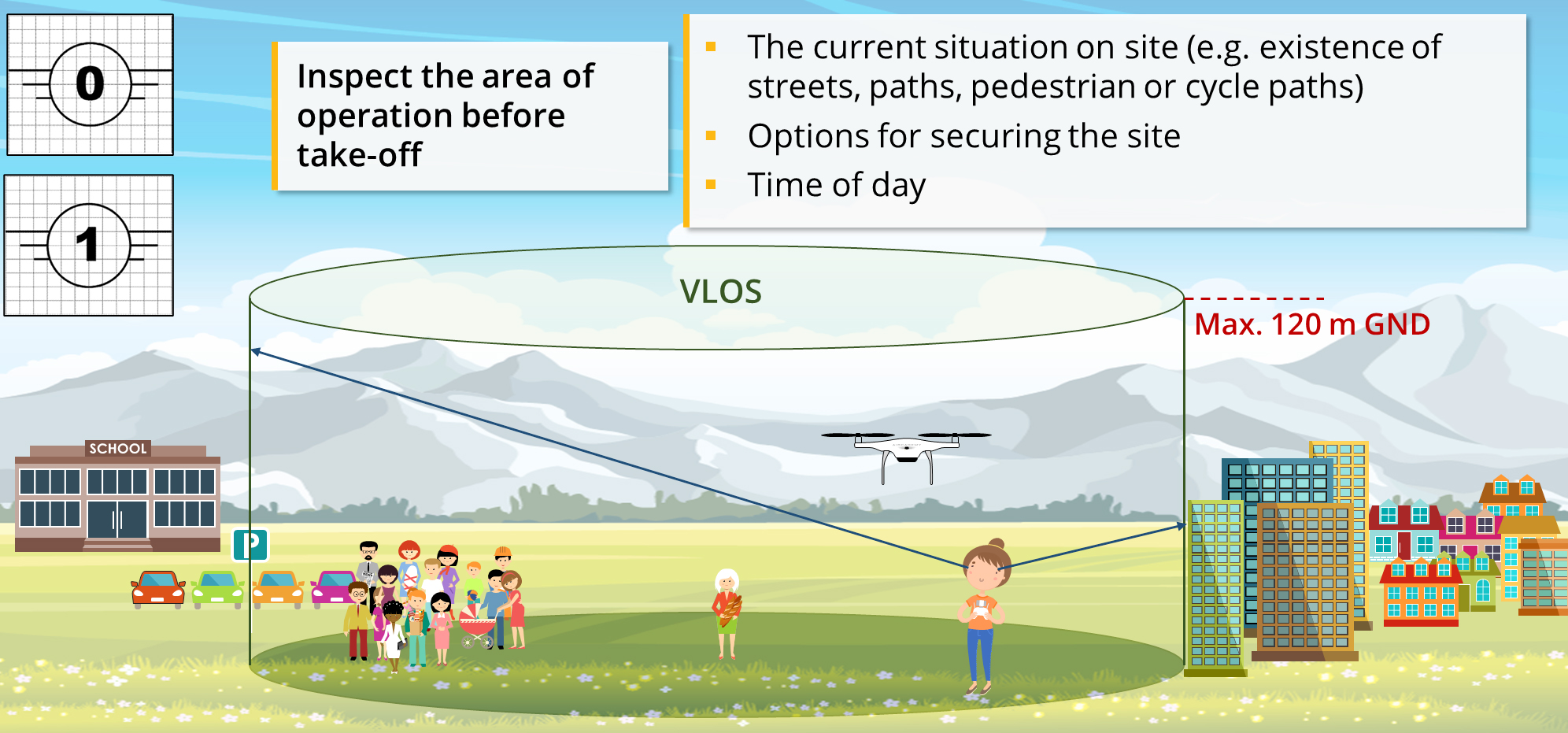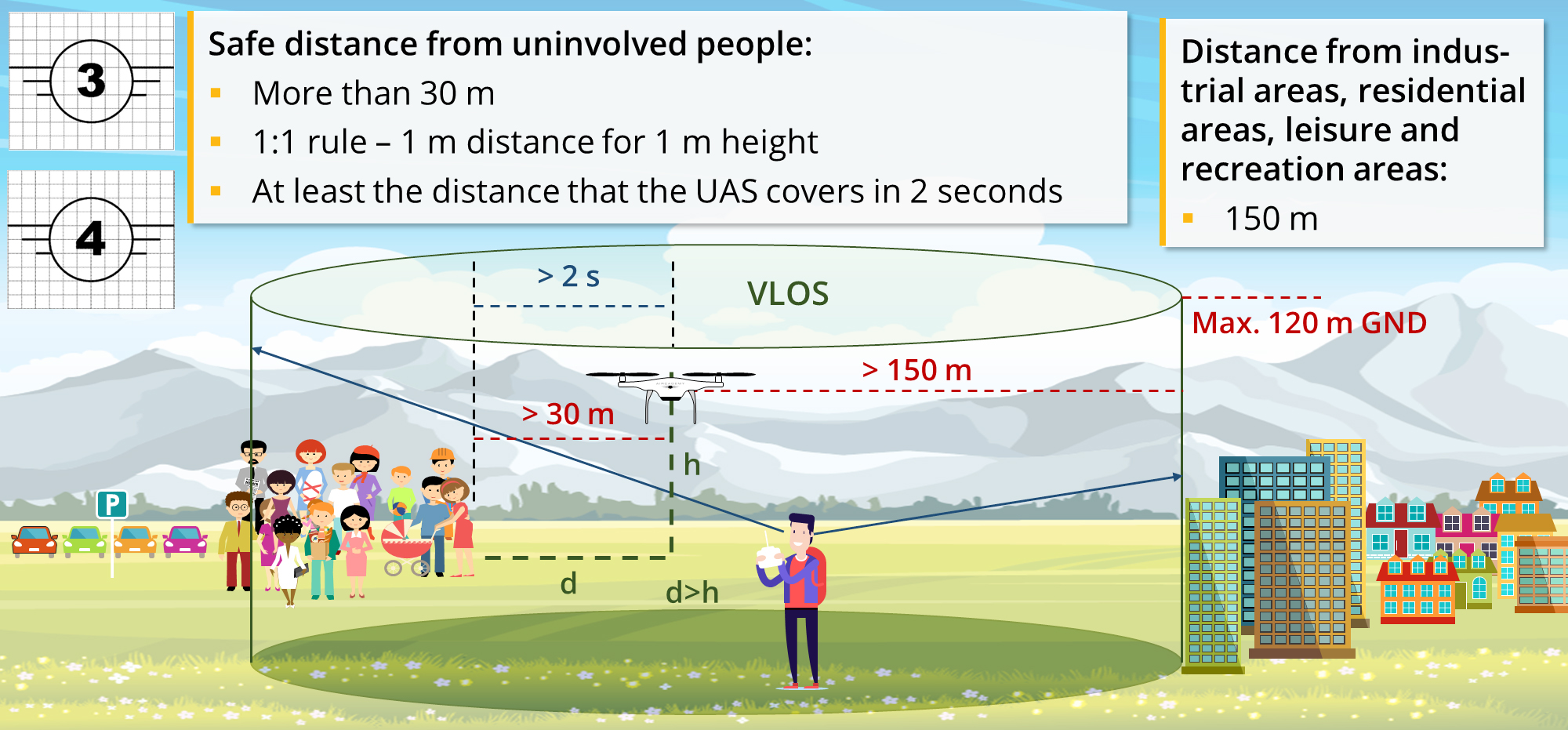UAS-Classification

The first part deals with the relevant technical and operational classifications of unmanned aircraft in the OPEN category.
An unmanned aircraft is any aircraft that is not controlled by a pilot on board. This means either that there is no pilot controlling the UAS at all (in the case of autonomously flying UAS, UAS taxis, parcel UAS) or that a remote pilot has control of the flight from the ground via a suitable remote control.
Some unmanned aircraft even have passengers on board – yet they are still called unmanned aircraft. Unmanned aircraft are officially called “UAS”. This is an abbreviation for “Unmanned Aircraft System”.
The different UAS categories, classes and associated rules are discussed below.
UAS Categories
Unmanned aircraft can be divided into different groups. For most UAS, EASA regulations apply, and these are divided into three categories:
- The OPEN category
- The SPECIFIC category
- The CERTIFIED category.
In addition, there are special cases which are not covered by EASA regulations:
- UAS for indoor use (i.e., mini UAS for the living room)
- unmanned aircraft used by special operators (i.e., the military, police, fire brigade, border guards, customs officials and coast guards).
An unmanned aircraft falls under the OPEN category if:
- its mass is below 25 kg,
- it is not operated over “assemblies of people” (this is defined as any gathering where persons are unable to move away due to the density of people present),
- it does not operate over an altitude of 120 m above the ground,
- it is only operated within the so-called Visual Line of Sight (VLOS)
- no dangerous goods or people are being transported.
A UAS falls into the SPECIFIC category if it meets one of the following criteria:
- its mass exceeds 25 kg,
- operation takes place above 120 m or in special air spaces
- operation takes place Beyond Visual Line of Sight (BVLOS).
A UAS falls into the CERTIFIED category if it meets one of the following criteria:
- the operation takes place over “assemblies of people”,
- dangerous goods are being transported
- people are transported.
This training material deals exclusively with the OPEN category.

Open Category
The UAS OPEN category is subject to the “lightest” regulations. However, the term “OPEN category” must not be misinterpreted – there are still regulations which apply!
The operation of UAS in the OPEN category usually does not require any prior approval or declaration. A flight in the OPEN category may be carried out if:
- the UAS meets the technical requirements
- the remote pilot complies with the operating rules
- the remote pilot is adequately qualified
- the operator is registered (if necessary).
Depending on the area of flight, the operation also falls into one of the sub-categories A1, A2 or A3. In addition, depending on the maximum take-off mass and the technical equipment, UAS are divided into one of the following “technical classes”, which are each assigned to a sub-category: C0, C1, C2, C3 or C4.
The risks associated with the operation of an unmanned aircraft always depend on several factors. The main factors are the mass of the UAS and the area of operation, e.g., the degree of settlement. A small, lightweight UAS usually causes little damage and can therefore be operated in close proximity to people. A larger, heavier UAS has the potential to kill a person in the event of a crash, which is why a minimum safety distance must be guaranteed.
The operating rules depend on the UAS size (C0–C4) and the area of operation (A1–A3).
Sub-category A1 is the least restrictive category – it allows unmanned aircraft to be operated even in densely populated areas and over isolated individuals (but not over crowds!). Only the lightest of UAS (900 g or less) may be used for this type of operation in order to minimise the risk of personal injury. No qualification is required for light UAS < 250 g; online training and an online exam are required for UAS between 250 g and 900 g.
Sub-category A2 allows the operation of heavier and larger unmanned aircraft (up to 4 kg), but only at a safe distance from people. For this purpose, the remote pilot must complete practical self-training and a theory test on site in addition to the online training and online test.

In sub-category A3, flights with unmanned aircraft with a mass up to 25 kg are allowed. As a safety precaution, however, with such large UAS, a large safety distance from all people, populated areas, industrial plants, etc. must be observed. Online training and an online exam are required as qualifications.
Technical Classes
To sell a product in the European Union, a “CE” mark is required. This mark certifies that the product meets the relevant standards for the European market.
In addition to the CE marking, unmanned aircraft sold in the European Union must also bear a class identification mark, which assigns them to one of the classes C0 to C4. Transitional rules for UAS manufacturers apply until 1 January 2023.

One of the main factors in deciding which class of UAS to buy should be the area of operation: whether an unmanned aircraft is operated close to or far away from people. The general rule is to always make sure to buy a UAS that has a CE mark and a class identification mark. Only such products may be flown in European airspace.
First, let’s look at the typical areas of operation of the different UAS classes:
- Class C0 UAS can be operated in areas where there is the possibility of the unmanned aircraft flying over uninvolved persons.
- With class C1 UAS, the remote pilot must make an assessment and assume that the unmanned aircraft will not fly over uninvolved persons.
- With class C2 UAS, the remote pilot must ensure that a horizontal minimum distance of 30 m (5 m in low-speed mode) from uninvolved persons is maintained at all times.
- UAS of classes C3 and C4 may only be operated in areas where no uninvolved persons are at risk of danger, and they must be operated at least 150 m away from residential areas, industrial plants, leisure facilities, etc.

These conditions correspond to the sub-categories of the OPEN category.
All unmanned aircraft in the OPEN category fall under one of these technical classes, which we will now take a closer look at. (There are additional EASA classes, C5 and C6, which, however, do not generally apply to the OPEN category.)
The class with the lowest requirements is class C4. An unmanned aircraft falls into this class if it does not meet the individual requirements of other classes. If it no longer meets the requirements for class C4 (e.g., because its mass exceeds 25 kg), it may no longer be operated in the OPEN category, but falls under the regulations for the SPECIFIC or CERTIFIED category.
The maximum take-off mass is specified by the manufacturer and describes the maximum mass of a UAS including all equipment, batteries, antennas, cameras, etc. at take-off.
For classes C0 and C1, there is a maximum speed limit of 19 m/s (this is the calculated value up to which a collision with a person should not cause serious injuries). Classes C2 to C4 have no speed limit; in those classes – due to the larger mass – there would be great risk of injury in the event of a collision with a person. Therefore, only UAS of classes C0 and C1 may be flown in the vicinity of people.
Class C0 UAS are equipped with a function that limits the maximum flight altitude to 120 m above the starting point. Although this cannot rule out airspace violations completely, it helps in avoiding unnecessary violations of the provisions relating to maximum flight altitudes and reduces the risk of collision with other aircraft. UAS of classes C1, C2 and C3 allow remote pilots to set a higher limit – e.g., in areas with looser regulations, in model aircraft areas or based on special permits.
In classes C1, C2 and C3, an altimeter is also required – i.e., a display on the controller that shows remote pilots the current altitude at any time. The following should be considered: the maximum altitude for UAS is 120 m, measured from the nearest point on the earth’s surface. There can, therefore, be situations in which the altimeter registers less than 120 m, but the UAS is still more than 120 m from the ground – for example, on steep mountain slopes!
The remote identification system allows people on the ground to identify unmanned aircraft in the area, where the remote pilot is and who the operator is. Such a system must be installed in UAS of classes C1, C2 and C3. This system continuously sends data about the UAS operator, the serial number, the geographic position of the UAS and remote pilot, as well as speed and current altitude. The system allows people on the ground to determine who is flying above them, the identity of the UAS, who owns it, where the remote pilot is and at what altitude the unmanned aircraft is moving. So, if you are looking down with a camera from above, remember they are also looking up at you from below!
If the UAS is equipped with a geo-awareness system, it automatically compares the data between the geographical zones published by the authority (e.g., flight restrictions for UAS) and the respective current position. As soon as the unmanned aircraft detects that it is flying in a forbidden zone, the remote pilot automatically receives a notification.
A geo-fencing system goes even further: it not only provides a notification but prevents flight in such an area (or even from entering the area). According to EU regulations, geo-fencing systems are possible, but not mandatory. Geo-awareness systems are compulsory for classes C1, C2 and C3.

OPEN Category A1
Sub-category A1 has the fewest restrictions. Unmanned aircraft of classes C0 and C1 may be operated in this sub-category.
With UAS of class C1, the remote pilot must inspect the area of operation before take-off and ensure that no uninvolved person is overflown. During this “situation assessment” the following should be taken into account:
- the current situation on site (e.g., existence of streets, paths, pedestrian or cycle paths)
- options for securing the site
- the time of day.
If uninvolved people are accidentally overflown, the duration of the overflight must be kept as short as possible. For example, the UAS could be flown higher and further away from the crowd as quickly as possible.
In any case, a visual line of sight to the UAS must exist and a height of 120 m above the ground must not be exceeded.
With UAS of class C0 or privately built UAS below 250 g, flying with extreme caution over uninvolved people is permitted. However, this should be avoided if possible.

OPEN Category A2
Operation in sub-category A2 is subject to the highest level of restrictions, as this is the category with the greatest risk: relatively heavy UAS (up to 4 kg) are operated in the vicinity of people (up to 30 m or 5 m in low-speed mode). Therefore, sub-category A2 has the strictest technical requirements and requirements for remote pilots in the OPEN category.
Since the risk of injury from unmanned aircraft increases when their speed is higher (e.g., due to the higher risk of control errors and higher impact energy), the safety distance depends on the air speed of the UAS. This is:
- 5 m during slow flight operations
- 30 m in all other instances.
A slow flight operation is given if the speed of 3 m/s (10 km/h) is not exceeded or if the UAS is a balloon or airship.
An even greater safety distance must be maintained if there are unfavorable conditions (e.g., strong wind or a low-charge battery level) or if the terrain or obstacles make this necessary.
In addition, the maximum height of 120 m above the ground must also be observed in this sub-category and operation within the visual line of sight must be guaranteed.
Remote pilots in sub-category A2 must meet a number of requirements to operate in this sub-category:
- complete an online course and an online test
- conduct practical training on your own
- pass a theory test on site.

OPEN Category A3
The largest and heaviest UAS are allowed to fly in sub-category A3. This sub-category is not as demanding as sub-category A2 with regard to the qualifications of the remote pilot, but it does require a significantly greater safety distance from anything that can be damaged by a UAS crash.
Accordingly, a minimum distance of 150 m must always be maintained in relation to industrial areas, residential areas, leisure and recreation areas.
Uninvolved persons must not be overflown – a safe distance must be maintained here. If it is not possible to maintain a safe distance from uninvolved persons, you must land immediately.
The safe distance is:
- more than 30 m,
- never less than the 1:1 rule (1 m distance for 1 m height)
- at least the distance that the UAS covers in 2 seconds, which roughly corresponds to the response time.
In addition, the maximum height of 120 m above the ground must be observed in this sub-category and visual operation must be guaranteed.

Content by AIRCADEMY
Graphics / Photos:
david henrichs on Unsplash, Deutsche Post AG, Alex Butterfield, CC BY 2.0, https://commons.wikimedia.org/w/index.php?curid=47202939, 142737069/Depositphotos.com, Natuska/Depositphotos.com, gurZZZa/Depositphotos.com, kondratya/Depositphotos.com, Zodchiy/Depositphotos.com
